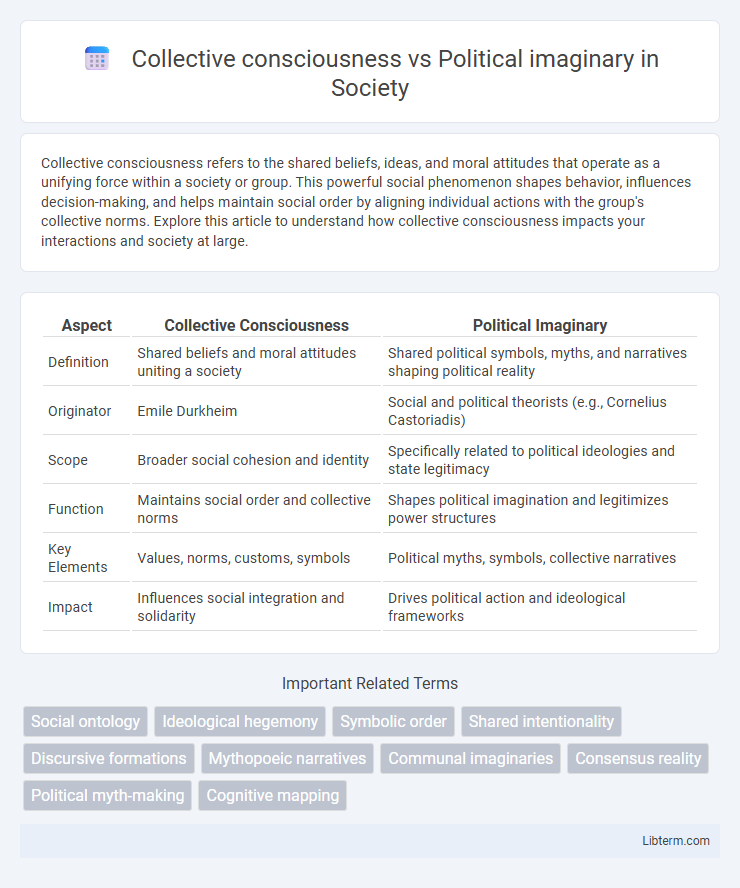Collective consciousness refers to the shared beliefs, ideas, and moral attitudes that operate as a unifying force within a society or group. This powerful social phenomenon shapes behavior, influences decision-making, and helps maintain social order by aligning individual actions with the group's collective norms. Explore this article to understand how collective consciousness impacts your interactions and society at large.
Table of Comparison
| Aspect | Collective Consciousness | Political Imaginary |
|---|---|---|
| Definition | Shared beliefs and moral attitudes uniting a society | Shared political symbols, myths, and narratives shaping political reality |
| Originator | Emile Durkheim | Social and political theorists (e.g., Cornelius Castoriadis) |
| Scope | Broader social cohesion and identity | Specifically related to political ideologies and state legitimacy |
| Function | Maintains social order and collective norms | Shapes political imagination and legitimizes power structures |
| Key Elements | Values, norms, customs, symbols | Political myths, symbols, collective narratives |
| Impact | Influences social integration and solidarity | Drives political action and ideological frameworks |
Understanding Collective Consciousness
Understanding collective consciousness involves recognizing shared beliefs, values, and norms that unify a group and influence social behavior at a societal level. It shapes collective identity and drives social cohesion by embedding common experiences and cultural symbols within a community. Unlike political imaginary, which is more focused on visions of political futures and power structures, collective consciousness provides the foundational framework of collective meaning essential for political imagination to arise.
Defining the Political Imaginary
The political imaginary constitutes the shared set of values, symbols, and narratives that shape a society's perception of political reality and possible futures. Unlike collective consciousness, which represents the general awareness and beliefs within a group, the political imaginary actively constructs visions of political order and social organization. This framework influences collective identities, legitimizes power structures, and guides political action by embedding ideological meanings in cultural and institutional practices.
Historical Origins of Both Concepts
Collective consciousness, rooted in Emile Durkheim's sociological theories from the late 19th century, refers to the shared beliefs, values, and norms that unify a society. The political imaginary, emerging prominently in the 20th century through thinkers like Cornelius Castoriadis and Benedict Anderson, encompasses the socially constructed visions and narratives that shape political identity and collective meaning. Both concepts trace their origins to efforts in understanding how societies create cohesion and legitimacy through shared mental frameworks and symbolic representations.
Collective Consciousness: Key Theories and Thinkers
Collective consciousness, a concept rooted in Emile Durkheim's sociology, refers to the shared beliefs, values, and norms that unify a society and shape social cohesion. Key thinkers like Maurice Halbwachs expanded this idea by introducing collective memory as a vital component, while Antonio Gramsci emphasized the role of cultural hegemony in maintaining collective consciousness within political contexts. This framework contrasts with political imaginary, which involves the dynamic and symbolic narratives that communities construct to envision political reality and possibilities.
The Political Imaginary in Modern Societies
The Political Imaginary in modern societies shapes collective identities and social norms by constructing shared visions of political reality that influence public behavior and institutional legitimacy. It operates beyond individual consciousness, embedding symbolic meanings and practices within cultural frameworks that sustain power structures and guide political participation. This imaginary interacts dynamically with collective consciousness, reflecting societal values while enabling adaptation to evolving political contexts.
Points of Intersection and Divergence
Collective consciousness refers to the shared beliefs, norms, and values within a society that shape social behavior and identity, while political imaginary encompasses the symbolic frameworks and narratives through which political communities envision their collective existence and possibilities. Both concepts intersect in their role of constructing social cohesion and influencing group identity, yet they diverge in scope: collective consciousness emphasizes real, internalized social norms and practices, whereas political imaginary focuses on imaginative, often aspirational or utopian political visions and mythologies. Understanding their intersection reveals how shared beliefs inform political narratives, while their divergence highlights the tension between actual societal consensus and politically constructed ideals.
Influence on Social Movements and Policy
Collective consciousness shapes social movements by fostering shared beliefs and values that unify participants and drive collective action, while political imaginary frames the aspirational visions and narratives that inspire policy innovation and reform. Social movements often emerge from the collective consciousness's common grievances, with the political imaginary providing creative possibilities for systemic change beyond existing structures. This dynamic interplay influences policymakers who respond to mobilized public sentiment and ideational shifts, resulting in transformative legislation and institutional reforms.
Media’s Role in Shaping Collective Beliefs
Media plays a crucial role in shaping collective consciousness by disseminating narratives that influence societal values, norms, and shared beliefs. Through framing political imaginaries, media outlets construct and reinforce visions of political reality, molding public perception and collective identity. This shaping of collective beliefs affects political engagement, social cohesion, and the formation of collective action within communities.
Challenges in Navigating Collective and Political Realities
Navigating collective consciousness and political imaginary presents challenges in reconciling shared beliefs with ideological constructs shaping societal actions. Conflicts arise when collective identities clash with political narratives, complicating consensus-building and policy implementation. Addressing these challenges requires critical analysis of power dynamics and historical contexts influencing collective and political realities.
Future Implications for Society and Democracy
Collective consciousness shapes societal norms and shared values that influence democratic participation and social cohesion, while political imaginary frames visions of future governance and societal organization. The interplay between these concepts determines how societies envision progress, respond to challenges, and mobilize collective action, impacting the evolution of democratic practices and institutions. Understanding this dynamic is crucial for fostering inclusive political engagement and adapting to emerging social and technological transformations.
Collective consciousness Infographic

 libterm.com
libterm.com